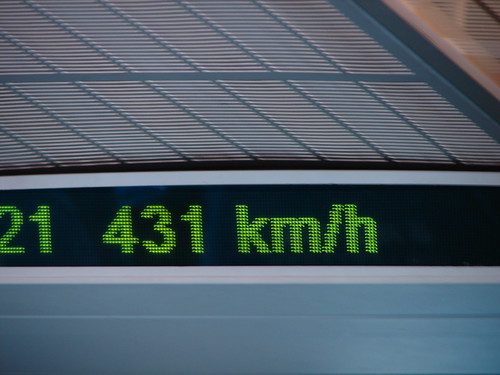
The Twitter social networking service often kicks off great discussions, and yesterday was a great example, with an exhange about carbon footprints and corporate travel between Craig Cmehil and Alan Wood. I asked Alan to tidy it up as a guest post for greenmonk, to illustrate the great grassroots conversations about economic greening occuring on social networks.
Craig works from home as a community evangelist at SAP, some way from its headquarters in Walldorf, near Heidelberg. Alan meanwhile is a resident of Farnham in Surrey. In case you’re wondering the @ sign refers to a Twitter username. I am pretty sure Alan and Craig have never met in “real life”.
@ccmehil: my trips [flights] to Walldorf caused 4 tonnes of CO2. need to use train more but it’s so expensive
@ccmehil: I’m almost double the avg carbon footprint for Germany thanks to flights that is…
@folknology: @ccmehil A European Maglev network would really help curb a lot of emissions.
The conversation continued…
One of the points made was the observation about the gradual movement of carbon responsibility from global to continental, national and even reaching down to organisations and individuals in the near future. So let’s imagine what that could mean.
Currently we are taxed directly on earnings but we are also burdened by selective lifestyle taxes on things like alcohol, tobacco and fuel. It doesn’t take a huge mental jump to imagine carbon taxes. Take this idea even further by superseding fixed taxation on purchases in the form of value added tax (VAT) with a variable ‘Carbon Added Tax’ (CAT). Such a tax would provide financial incentives to reduce carbon footprints not just at individual levels but also within manufacturing, as those goods with lower carbon footprints would be financially advantaged. Thus our consupmtion would likely shift to lower carbon footprint goods.
But Craig and his peers will be operating within organisations that impose high carbon footprints on some of their employees. Should Craig bear that in Pay As You Earn (PAYE) taxes? I think not.
More likely the organisation will eventually have to put travel expenses through a special ‘Carbon tax analyser’ in order to calculate it’s tax liability to the government. Thus the organisation will likely have to bear such taxation costs above the individual norms. This may help them in turn decide on more carbon efficient travel choices.
Craig was directly referring to a difficulty with his (and many other business travelers): working carbon footprint. The nature of his work mean a lot of travel, much of that across continental Europe (among other continents). Even though Craig tries to reduce his carbon footprint using energy saving matters at his home and with his personal transport, his carbon foot print becomes oversized by his professional travel burden.
When Craig’s experience is interpolated to all business travelers it adds up to a mighty tonnage of carbon. The main culprit is of course is the size 15XL boot of the aviation industry forced under most business traveler’s legs. However a considerable more efficient mode of transport is available to us in the 21st century: it’s fast, efficient and high tech, ironically it was developed in the last century.
The solution? Maglevity
What is this magical transport solution? A European Maglev network. The technology was pioneered originally in the UK and brought to engineering maturity in Germany. The first roll out in Europe comes in Bavaria in 2009. So why are we not being whisked around Europe on these high tech magic carpets? Why does it take the Chinese and the Japanese nations to commercially pioneer Maglev usage?

Why can Europe not commercialise the technology with a European Maglev network? The time is right. The network would help Craig and his peers significantly reduce their carbon footprint opting for Maglev over carbon unfriendly aviation. Here some of the things we came up with that likely represent resistance to the idea :
Some obstacles (mostly political):
1. Airbus and other aviation interest within Europe.
2. The automobile industry within Europe.
3. The Carbon cost of actually building the network.
4. The financial cost.
Some of our possible responses :
1. The aviation industry will need to compete not just on cost but on carbon footprint per journey to remain competitive (And yes I expect Maglev fare subsidies initially).
2. The automobile industry must also compete with Maglev for long journeys but not for short trips. Also automobiles will drastically reduce their carbon footprints over the next decade.
3. There will be a large carbon cost to build the Maglev network, think lots of concrete and steel. Perhaps more carbon friendly replacements could help keep the cost down. Long term of course the carbon cost would be recouped by the efficiency of the network.
4. There will be an enormous financial cost spread across Europe, perhaps some of this could be recouped or offset via emission trading.
Conclusions:
If Europe is serious about carbon footprint reduction then a continent-wide Maglev network needs to be high on the agenda: political obstructions and financial costs need to be overcome, otherwise carbon friendly actions by folks like Craig in their personal life will remain insignificant compared to their business life. Also I would imagine more general travel and expense carbon costing to enter organisational taxation, along with carbon based sales taxation. Most politicians are of course nervous about pretty much all of this, so its really up to us to discuss it and take the conversation to them, what do you think are Craig and I talking sacrilege, or are we all prepared to make the difficult decisions?
photos courtesy of Helga’s Lobster Stew, and jyzz, under CreativeCommons Attribution 2.0 license, posted from Flickr.

Ever since that conversation (very glad Alan put it together and got it posted here) I’ve been on a bit of a mission to figure out what more I can do at home as well as with work to reduce my carbon footprint – seeing it so much higher than the average in Germany was quite a shock as we are normally very good at not being wasteful with energy and such.
The idea of CAT is a very interesting but (can always be very scary) I’ll be following this topic a lot closer now that I had my eyes opened – although I’ve tried several different ones of these Carbon Calculators and each varies quite a bit.
Hi,
Agree with your point but with two nuances:
1. Maglev is a power hog, much more than steel-on-steel. But since the UK is going back into nuclear, it’s less of an issue?
2. The main point though is on reducing friction, not from a technology standpoint but more on individual journeys: reduce the number of interconnections (for instance by removing intermodal discontinuities) and adoption climbs rapidly.
In this respect, pan-european TGV like France is spearheading works but only if there’s sufficient parking at stations and easy connection with local public transports. The smartest at this are the Dutch who have two bikes: one at each station of their daily commute, plus bike-sheds with repair facilities.
In a nutshell, make it easy by investing into infrastructure and the air CO2 emissions (although is CO2 the real issue?) will diminish:
http://richmondtransits.blogspot.com/2007/11/more-on-heathrow.html
Much more efficient in the long term than simply taxing cars. But isn’t short termism the root cause of anthropogenic climate change?
PS: France invented both Airbus and TGV’s
PPS: a way to deal with cost is to look at indirect costs. Why is aviation fuel not taxed? Why are landings after say 20:00 not taxed more in benefit of soundproofing homes? etc…
More food for thought on the Maglev conversayion :-
These figures are interesting :
Domestic Air Travel – 3,297 BTU/Passenger mile
Rail (Amtrak) – 2,100 BTU/Passenger mile
from the states see this post :
http://gristmill.grist.org/story/2007/2/20/145915/169
But obviously Maglev will be nearer that of airtravel, aviation however cannot be fueled by carbon freindly energy.
This post indicates more figures including maglev :
http://strickland.ca/efficiency.html
Fo reference this is a report from the 90s by the U.S. dept of transportation, it looked quite favorable on a U.S. developed Maglev product prior to the political recognition of climate change, interesting never the less.
This is also another possible glimpse of the future of Maglev being even more carbon friendly : http://newenergynews.blogspot.com/2007/11/china-in-big-mag-lev-wind-build.html
It is also ironic that some early Maglevs where used to connect Airports to cities!
Oops forgot the ntl link :
http://ntl.bts.gov/DOCS/TNM.html
There is something poetic about Maglevs powering maglevs